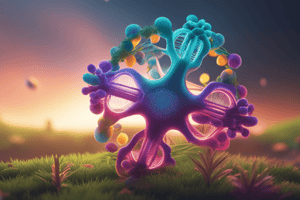Podcast
Questions and Answers
What did Mendel's experiments on pea plants demonstrate?
What did Mendel's experiments on pea plants demonstrate?
- Traits in plants and animals remain distinct in subsequent generations (correct)
- Pure-bred parent plants do not pass on dominant traits to the progeny
- Recessive traits are always visible in the first-generation hybrid plants
- Traits in plants and animals are blended in subsequent generations
What is the basis of inheritance according to Mendel?
What is the basis of inheritance according to Mendel?
- Continuous transfer of traits from one generation to the next
- Inheritance involves the passing of discrete units of inheritance, or genes, from parents to offspring (correct)
- Inheritance does not involve the passing of genes from parents to offspring
- Inheritance is influenced by environmental factors
What were the results when pure-bred parent plants were cross-bred according to Mendel's experiments?
What were the results when pure-bred parent plants were cross-bred according to Mendel's experiments?
- Recessive traits always dominated over dominant traits
- Dominant traits were not passed on to the progeny
- Dominant traits were always seen in the progeny (correct)
- Recessive traits were always visible in the progeny
What are the exceptions to Mendel's laws of inheritance?
What are the exceptions to Mendel's laws of inheritance?
What is the current understanding about Mendel's laws of inheritance?
What is the current understanding about Mendel's laws of inheritance?
Flashcards are hidden until you start studying
Study Notes
Gregor Mendel, an 19th- century scientist, is known for his work on the principles of inheritance. He proposed the laws of inheritance, which have been universally accepted and are still used to explain how traits are passed from one generation to the next. Mendel's work was not only a fundamental basis for understanding heredity but has been a key to understanding the genetic basis of many traits in plants and animals, from eye hair colour to tongue-rolling ability.
Mendel's principles of inheritance can be described as the laws of inheritance, which include:
-
Law of dominance: This law states that when pure-bred parent plants are cross-bred, dominant traits are always seen in the progeny, whereas recessive traits are hidden until the first-generation (F1) hybrid plants are left to self-pollinate.
-
Law of segregation: This law states that each trait consists of two alleles, which segregate during the formation of gametes. It is known as the law of purity of gametes because a gamete carries only one allele.
-
Law of independent assortment: This law states that a pair of traits segregates independently of another. It means that different traits get equal opportunity to occur together.
Mendel's work was not only a fundamental basis for understanding heredity but has been a key to understanding the genetic basis of many traits in plants and animals. He worked on pea plants, but his principles apply to traits in plants and animals. Mendel's experiments on pea plants were the first to show that traits were not blended but remained distinct in subsequent generations.
Inheritance involves the passing of discrete units of inheritance, or genes, from parents to offspring. Mendel found that paired pea traits were either dominant or recessive. When pure-bred parent plants were cross-bred, dominant traits were always seen in the progeny, whereas recessive traits were hidden until the first-generation (F1) hybrid plants were left to self-pollinate.
Mendel's laws of inheritance have been universally accepted and are still used to explain how traits are passed from one generation to the next. However, it is now known that these laws have exceptions, such as incomplete dominance, pleiotropy, and epistasis. These exceptions complement the rules and together form a unified framework for understanding the basis of inheritance
Studying That Suits You
Use AI to generate personalized quizzes and flashcards to suit your learning preferences.




